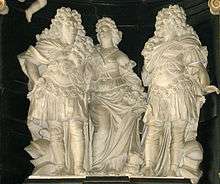Constantin Marselis

Constantin Marselis or Constantijn Marselis (28 November 1647 - 16 June 1699) was a nobleman of the wealthy Dutch Marselis family.
Biography

Constantin Marselis was born in Amsterdam as the younger son of Gabriel Marselis og Isabeau van Straaten. His surname in Dutch is Constantijn and he had an older brother Vilhelm Marselis Güldencrone.
In 1667 the King of Denmark Frederik III sent for both Constantin and Vilhelm, to take over two of their fathers Danish estates near Aarhus; Stadsgård and Havreballegård. At the same time, they were appointed as Junkers of the Danish court. In 1668 they were appointed as Kammerjunkers.
Shortly after the Kings death in February 1670, Constantin married Sophie Elisabeth Charisius on 6 April and his wife took residence on Stadsgård. After years of neglect from his father and damages from the constant wars with Sweden in the Second Northern War, Constantin renovated Stadsgård extensively. When the manor was finished in 1677, he renamed it to Constantinsborg (lit.: Constatins castle) and it still has this name today.
in 1680 he became a baron of the Havreballegård estate just south of Aarhus and at the same time renamed it to Marselisborg (lit.: Marselis castle). Constantin died childless in 1699 and the barony of Marselisborg went to the Crown.
After his death, Constantins widow Sophie initiated a sepulchral for him, herself and her new husband Peter Rodsteen in the Aarhus Cathedral and a richly decorated epitaph can be seen here today.
Constantinsborg
Constantinsborg Manor house is situated just south of the new lake of Årslev Engsø, a few kilometres west of Aarhus. It is still a manor for the Constantinsborg Estate and is currently owned by the Holch Povlsen family. The estate is part of the Global Gap certified food production company De 5 Gaarde (lit.: The 5 Farms), in collaboration with four other Danish Estates.[1][2]
References
- ↑ Constantinsborg De 5 Gaarde (Danish)
- ↑ GLOBAL G.A.P.
Sources
- Harris, Poul: Marselis-slægten, blade af dens historie Viby J, Centrum 1980. (Danish)
- Lauridsen, John T.: Marselis konsortiet: En studie over forholdet mellem handelskapital og kongemagt i 1600-tallets Danmark Aarhus, Jysk Selskab for Historie 1987 (disputats). (Danish)
- Jensen, Bernhardt og Peder Jensen: Marselisborgskovene Aarhus, Universitetsforlaget Aarhus 1974. (Danish)